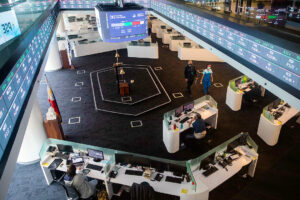
Analysts: PHL stocks did well in Q1, but risks loom ahead
By Revin Mikhael D. Ochave, Reporter
PHILIPPINE SHARES performed well in the first quarter (Q1) but might face challenges ahead due to higher inflation and interest rates, according to analysts.
“(Local markets) performed well across many metrics,” China Bank Capital Corp. Managing Director Juan Paolo E. Colet said in a Viber message on Tuesday.
“The index is up more than 7% year to date and has gained more than 16% from its 52-week low. Foreign funds are steadily flowing back, with net foreign buying exceeding P10 billion compared with the P27.4-billion net foreign selling in the first quarter of 2023. It is also good to see that the rally is broad based as around 54% of stocks are trading higher year to date,” he said.
On March 27, the Philippine Stock Exchange index (PSEi) ended at 6,903.53, up by 7.03% year to date. Philippine financial markets were closed for Maundy Thursday and Good Friday.
The PSEi fell by 0.27% or 19.38 points ending at 6,960.43, while the broader all shares index dropped by 0.26% or 9.69 points closing at 3,626.71 on Tuesday.
The local bourse was resilient in the first quarter but could have performed better, AB Capital Securities, Inc. Vice-President Jovis L. Vistan said in a Viber message.
“This sentiment stems from the promising economic growth forecasts for the Philippines. Despite these optimistic projections, it appears we may have fallen short in comparison,” he said.
For his part, Philstocks Financial, Inc. Senior Research Analyst Japhet Louis O. Tantiangco said the market rallied in the first two months of 2024 but lost momentum by March.
“In March, the rally lost steam. Mounting upside risks to inflation from the impact of El Niño on our agricultural sector, to rising oil and energy prices dampened sentiment. Consequently, Bangko Sentral ng Pilipinas (BSP) rate cut hopes were also tempered, which in turn weighed on the market. As a result, the market posted losses in March,” he said in a Viber message.
“By March’s close, the market is trading at a price-to-earnings ratio of 14x, below its last five years’ average of 18.2x. This is also below its peers’ average of 18.2x. This shows that the market is still at attractive levels. However, our inflation and interest rate outlook remains as a key risk to the market’s movement moving forward,” he added.
The inflation figure for March will be released by the Philippine Statistics Authority on April 5.
Philippine inflation accelerated to 3.4% in February from 2.8% the prior month due to higher food prices.
Mr. Tantiangco also expressed cautious optimism regarding the market’s trajectory in the coming quarters.
“I’m optimistic since from a fundamental standpoint, our corporate sector remains robust with many still deemed to be undervalued. However, I’m also cautious given the key risks at play namely inflation and interest rates,” he said.
“Inflation exceeds and is sustained above the government’s 2%-4% target again, there’s the possibility that the BSP’s monetary easing would be delayed. This would lead to soured sentiment, which in turn could make it hard for the market to rise further,” he added.
Mr. Vistan said that one concern for the local stock market is the country’s susceptibility to “inflation-related shocks.”
“The Philippines faces potential impacts stemming from volatile oil prices and agricultural commodities such as rice. These factors introduce an element of unpredictability, posing challenges for sustained market stability and growth,” he said.
Mr. Colet noted that the local market’s average daily turnover is still lagging compared to last year, with the year-to-date daily average value turnover at P6.03 billion as of March 27th.
“One market statistic that is lagging is the average daily value turnover, which is still lower than the P7.7 billion in the same period last year. This relatively low value turnover tells us that there are still a lot of funds that have not returned to the local equity market, perhaps because the debt market continues to offer attractive yields,” Mr. Colet said.
“There is a silver lining here. Once policy rates start falling and equities re-rate, then we may see a boost in value turnover that could support a sustainable market rally,” he added.
The BSP kept the key rate at 6.5% — the highest in nearly 17 years — for a third straight meeting in February.
“Overbought PSEi large caps and hawkish local monetary policy stance could stoke PSEi volatility in April, opening up buying window toward renewed market attempts to reach 7,000 as inflation continues to stay mid-target in the first quarter and corporate earnings show momentum,” First Metro Investment Corp. Head of Research Cristina S. Ulang said in a Viber message.
Meanwhile, Mr. Vistan said the local bourse could end on a strong note in 2024 if the BSP eases interest rates.
“The pivotal juncture emerges around midyear when the base effect on inflation reaches its peak severity… should we manage to look beyond it and witness the BSP easing monetary policies, we can anticipate finishing the year on a strong note, fostering heightened optimism for 2025,” he said.
Mr. Colet said the market is consolidating after trading resumed following the Holy Week break.
“After failing to close above 7,000 in early March, the market is now in consolidation mode, a pattern that may persist in the second quarter until inflation concerns abate and there is more confidence on the timing of interest rate cuts,” he said.



